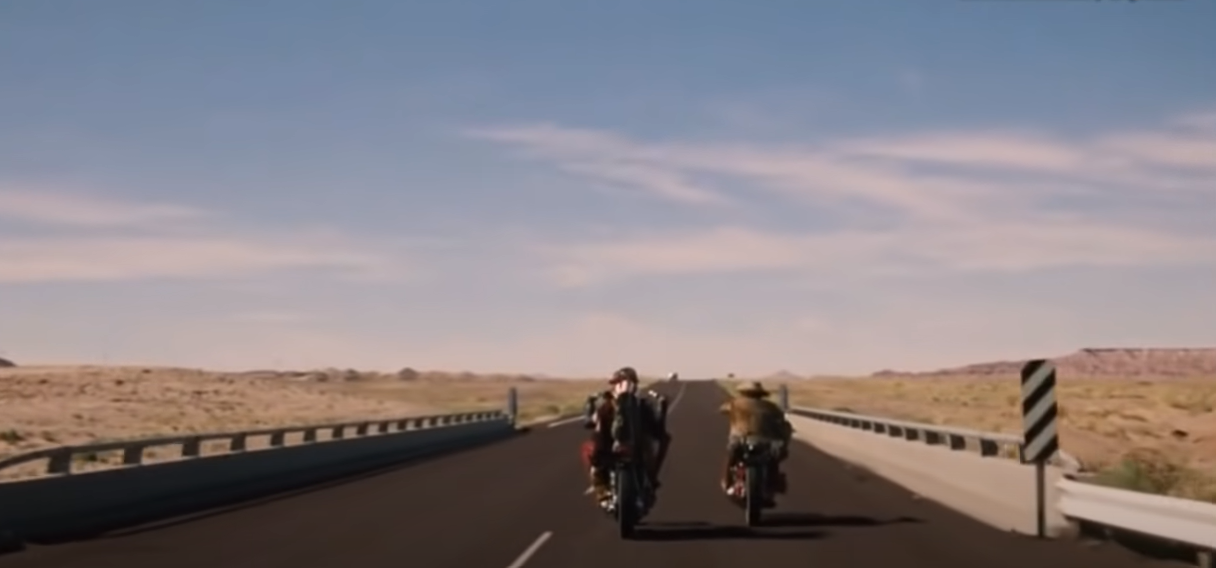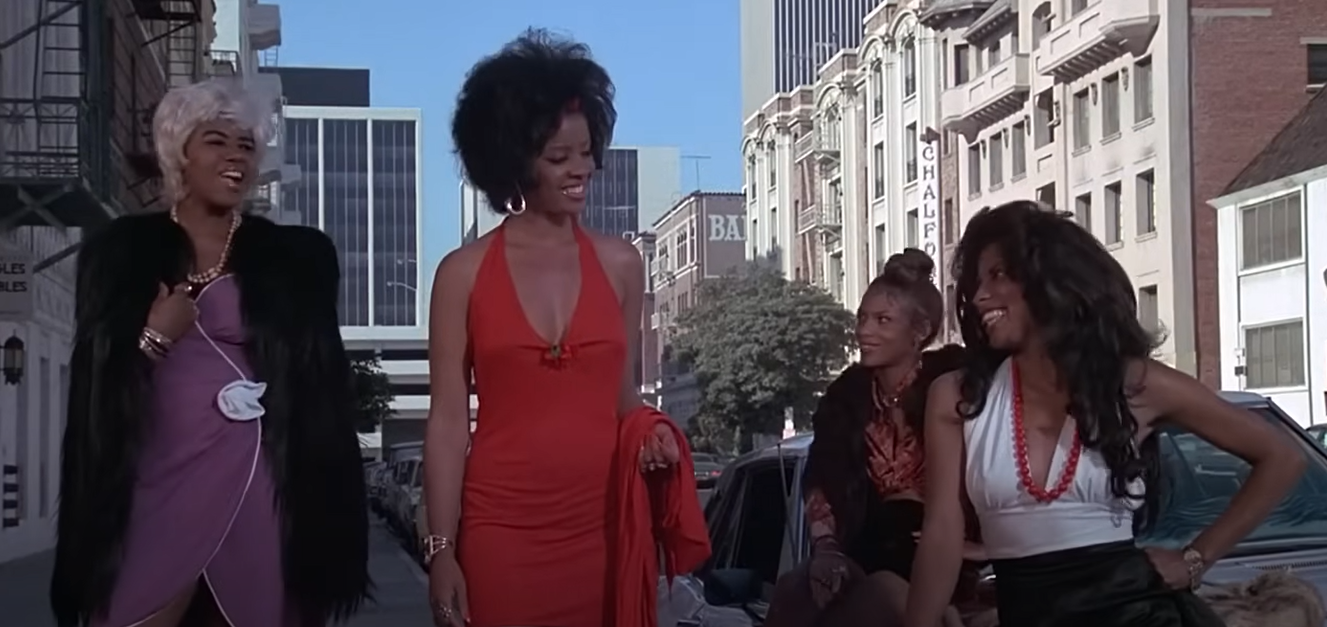Straddling Freedom: Motorcycle Movies that Defined an Era
The 1970s marked a prolific era in cinema history, particularly for the motorcycle film genre. From the daring escapades of rebellious bikers to the exploration of counterculture movements, these films not only captured the essence of motorcycling but also echoed the zeitgeist of the times. Some of the key movies that highlighted motorcycle culture in the 1970s include:
Easy Rider (1969)
Easy Rider (1969), directed by Dennis Hopper, co-written by Peter Fonda and Terry Southern, and produced by Fonda, is an enduring classic in the landscape of American cinema. This 95-minute film, which takes its audience on a captivating journey through the American Southwest and South, is more than a story of two bikers on a trip; it’s a potent symbol of a shifting culture and the birth of New Hollywood.
The Era of New Hollywood
Before delving into the significance and impact of Easy Rider, it’s necessary to place it within its wider context: the emergence of New Hollywood.
- New Hollywood (1967–1980): Often referred to as the “American New Wave”, this era in American film history is characterized by a greater emphasis on artistic vision, edgier themes, and an exploration of societal issues;
- Major Influences: The decline of the studio system, the rise of independent cinema, increasing societal tensions and changes, as well as foreign cinematic innovations significantly contributed to the emergence of this era;
- Breakthrough Films: Alongside Easy Rider, other notable films from this period include The Graduate (1967), Bonnie and Clyde (1967), and Midnight Cowboy (1969).
Easy Rider encapsulated the spirit of New Hollywood, with its independent production, non-traditional narrative, exploration of counterculture, and anti-establishment sentiments.
Journey into the Heart of America
Easy Rider takes us on an odyssey with Wyatt (Peter Fonda) and Billy (Dennis Hopper), two free-spirited bikers who embark on a journey from Los Angeles to New Orleans. The film is both a physical road trip through stunning landscapes and a metaphorical journey into the American ethos of the late 60s.
Key Elements of the Journey:
| Aspect | Description |
|---|---|
| Drug Culture | Wyatt and Billy’s trip is funded by a cocaine deal, which sets the tone for the film’s exploration of drug use and its significance in the counterculture of the 60s. |
| Soundtrack | The film’s soundtrack became as iconic as the film itself, featuring bands like Steppenwolf, The Byrds, and Jimi Hendrix. The songs weren’t mere background music; they contributed to the narrative. |
| Reflecting the characters’ inner thoughts and feelings. | |
| The Hippie Commune | The commune scene provides a microcosm of the hippie lifestyle and ethos: communal living, free love, self-sufficiency, and a return to nature. |
| The Mardi Gras Scene | The frenetic, hallucinatory Mardi Gras sequence, with its disjointed editing and sound design, was a stark departure from classical Hollywood storytelling. |
Significance and Impact
Easy Rider was groundbreaking in numerous ways, reshaping cinema both aesthetically and thematically.
Aesthetic Innovations:
- Cinematography: The film’s cinematography, led by Laszlo Kovacs, pushed the boundaries of visual storytelling. The vast American landscapes, seen from the bikers’ perspective, symbolized freedom and adventure;
- Editing: The film’s disjointed editing style, particularly in the Mardi Gras sequence, eschewed traditional narrative conventions, aiming instead to create an immersive, sensory experience.
Thematic Relevance:
- Societal Critique: The film portrayed the tension between mainstream society and counterculture, the search for personal freedom, and the disillusionment with the American Dream;
- Exploration of Freedom: Throughout their journey, Wyatt and Billy encounter different versions of freedom, from the carefree lifestyle of the commune to the constrained existence in the conservative Southern towns.
Easy Rider’s success also had tangible effects on the industry, proving that low-budget, independent films could be commercially successful and that young filmmakers had stories worth telling.
The Wild One (1953)
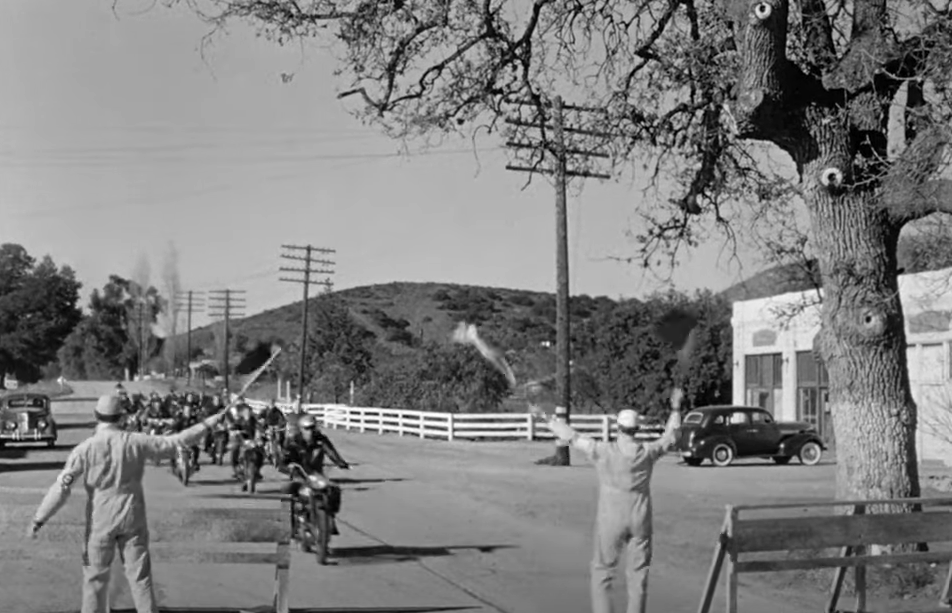
The Wild One (1953) is a landmark film in American cinema that introduced Marlon Brando’s iconic image as a rebellious biker, a portrayal that resonated with audiences and influenced a myriad of films in the subsequent decades. Directed by Laslo Benedek and produced by Stanley Kramer, The Wild One presents a timeless narrative of rebellion and non-conformity.
The Wild One and the Emergence of Youth Culture
The Wild One is an early representation of the emerging youth culture in the 1950s, an era characterized by the rise of rock ‘n’ roll, an economic boom that provided more disposable income for teenagers, and a growing spirit of rebellion.
Key Aspects of 1950s Youth Culture:
- Rock ‘n’ Roll: This genre of music, with its pulsating rhythms and rebellious themes, became a symbol of youth culture and rebellion;
- Teenage Consumers: The booming economy of the 1950s provided teenagers with disposable income, leading to the rise of youth-oriented products and media;
- Motorcycle Clubs: The rise of motorcycle clubs symbolized the freedom and rebelliousness of the youth.
In this context, The Wild One emerged as a cultural phenomenon, capturing the spirit of this rebellious youth culture.
Plot and Characters: A Tale of Two Biker Gangs
The Wild One revolves around the clash of two motorcycle gangs in a small California town. At the heart of the story is Johnny Strabler (Marlon Brando), the brooding leader of the Black Rebels Motorcycle Club.
Key Elements of the Plot:
| Character/Aspect | Description |
|---|---|
| Johnny Strabler | A nonconformist and rebel, Johnny embodies the free-spirited and defiant ethos of youth culture. |
| The Black Rebels vs. The Beetles | The rival gang, The Beetles, led by Chino (Lee Marvin), serves as a counterpoint to Johnny’s gang and intensifies the film’s conflict. |
| Kathie | Played by Mary Murphy, Kathie is the local girl who develops a complex relationship with Johnny, adding an emotional layer to the film. |
Impact of The Wild One on Cinema and Culture
The Wild One made a lasting impact on cinema and popular culture. Its exploration of rebellion, freedom, and non-conformity resonated with audiences and influenced numerous films in the following decades.
Influence on Cinema:
- Rebellious Characters: Brando’s portrayal of Johnny became a template for rebellious characters in subsequent films;
- Motorcycle Films: The Wild One set a precedent for motorcycle-themed films, such as Easy Rider (1969), which continued the exploration of biker culture and rebellion;
- New Hollywood Cinema: The Wild One’s themes of rebellion and anti-establishment sentiments echoed through the films of the New Hollywood era in the late 1960s and 1970s.
Influence on Popular Culture:
- Fashion: The film popularized the biker look – a leather jacket, jeans, and a cap, which became synonymous with rebellion and has remained a popular fashion statement;
- Rock ‘n’ Roll: The rebellious spirit of The Wild One resonated with the emerging rock ‘n’ roll culture, and the film itself influenced many rock songs;
- Iconic Dialogue: The film’s dialogue, especially Johnny’s response when asked what he’s rebelling against – “Whaddya got?” – became an iconic symbol of youthful rebellion.
Legacy of The Wild One
The legacy of The Wild One is enduring. It is not only a seminal film in the motorcycle genre but also a touchstone in American cinema that heralded the advent of the rebellious youth film genre.
Lasting Impact:
| Aspect | Description |
|---|---|
| Film Preservation | The Wild One was selected for preservation in the United States National Film Registry by the Library of Congress as being “culturally, historically, or aesthetically significant”. |
| Marlon Brando’s Legacy | The film solidified Marlon Brando’s image as a screen rebel, a persona he would further establish in On the Waterfront (1954) and A Streetcar Named Desire (1951). |
| Influence on Filmmakers | Directors like George Lucas, Francis Ford Coppola, and Martin Scorsese have acknowledged the influence of The Wild One on their work. The film’s impact is evident in their filmmaking styles and themes. |
On Any Sunday (1971)
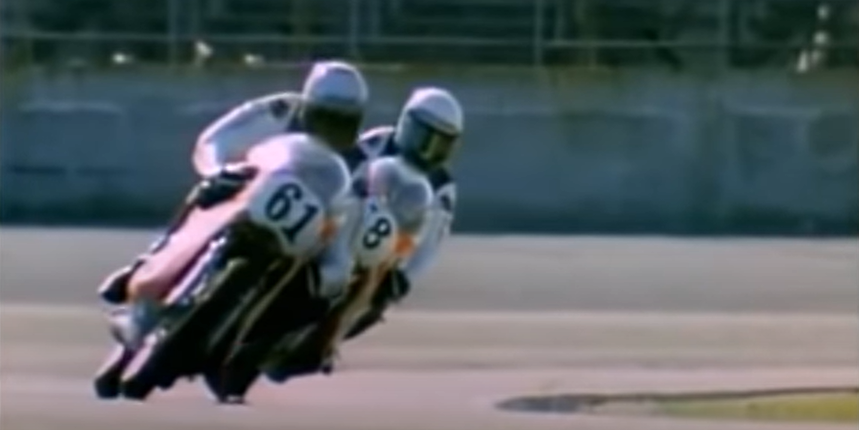
On Any Sunday (1971), directed by Bruce Brown, is a seminal documentary that brought the sport of motorcycling to the forefront of popular culture. Unlike its fictional predecessors that typically focused on rebellious bikers, On Any Sunday celebrated the exhilaration, camaraderie, and dedication involved in motorcycling, showcasing not only the thrill of the sport but also the individuals who dared to push the boundaries.
The Man Behind the Camera: Bruce Brown
Bruce Brown was a renowned filmmaker whose work, primarily focused on action sports, often transcended the genre to touch upon universal themes of human endeavour, dedication, and adventure.
- The Endless Summer (1966): Before making On Any Sunday, Brown gained fame with this documentary that followed two surfers around the world in search of the perfect wave;
- Passion for Sports: Brown’s work showcased his deep appreciation for action sports and the individuals who devote their lives to these pursuits.
With On Any Sunday, Brown turned his lens on the world of motorcycling, capturing its spirit with authenticity and passion.
Riding with the Legends: McQueen, Lawwill, and Malcolm
On Any Sunday showcased the world of professional motorcycling through the eyes of three individuals: Hollywood actor Steve McQueen, professional racer Mert Lawwill, and off-road racer Malcolm Smith.
Key Characters:
| Name | Description |
|---|---|
| Steve McQueen | A renowned actor and a dedicated motorcycle enthusiast, McQueen’s involvement not only drew attention to the film but also added an additional layer of celebrity charisma. |
| Mert Lawwill | The reigning AMA Grand National Champion at the time, Lawwill’s journey throughout the season offered an inside look at the rigors and excitement of professional racing. |
| Malcolm Smith | A legend in off-road racing, Smith’s passion and humble demeanor provided a contrast to the often glitzy world of professional sports. |
Cinematic Impact of On Any Sunday
On Any Sunday had a significant impact on sports documentaries, motorcycling, and popular culture, setting new standards for action sports filmmaking.
Innovations in Filmmaking:
- Dynamic Cinematography: Brown’s innovative use of cameras, including helmet-mounted cameras, captured the speed and thrill of motorcycling like never before;
- Narrative Structure: Rather than simply documenting races, the film delved into the lives of its subjects, creating a human connection that broadened the appeal of the film beyond motorcycling enthusiasts.
Influence on Motorcycling and Culture:
- Popularity of Motorcycling: The film played a significant role in popularizing motorcycling in America and around the world;
- Influence on Sports Documentaries: On Any Sunday set a template for future sports documentaries, showcasing the potential of the genre to transcend sports and capture broader human experiences.
Legacy of On Any Sunday
Almost half a century since its release, On Any Sunday remains a classic in sports documentaries, celebrated for its authentic portrayal of motorcycling.
Enduring Significance:
| Aspect | Description |
|---|---|
| Cult Status | On Any Sunday has achieved cult status among motorcycling enthusiasts and sports documentary fans for its passionate and authentic portrayal of the sport. |
| Sequels and Tributes | The film inspired several sequels and tributes, including On Any Sunday II (1981), On Any Sunday: Revisited (2000), and On Any Sunday: The Next Chapter (2014), which continued to explore the evolving world of motorcycling. |
| Preservation | In recognition of its cultural significance, On Any Sunday was selected for preservation in the United States National Film Registry by the Library of Congress in 2002. |
Psychomania (1973)
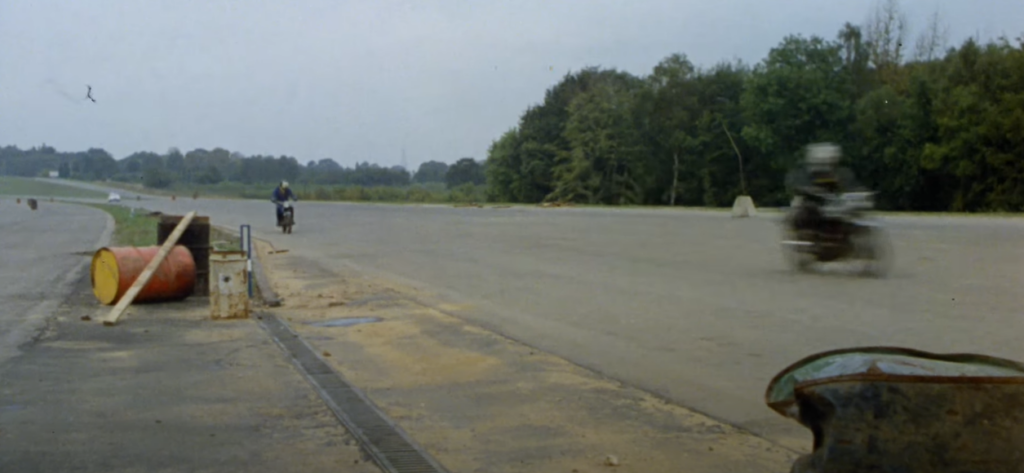
Psychomania (1973) offers a unique, audacious blend of biker and horror genres, a cinematic mash-up that dares to tread a path less traveled. Directed by Don Sharp and written by Julian Halevy and Arnaud d’Usseau, the film revolves around a gang of bikers who, through occult means, acquire the ability to return from the dead.
Contextualising Psychomania within Biker Cinema
Biker cinema emerged as a subgenre in the late 1950s and 1960s, primarily in response to societal changes and the rising youth counterculture. Notable entries such as The Wild One (1953) and Easy Rider (1969) embodied the spirit of rebellion and freedom associated with motorcycle culture.
Psychomania, with its innovative combination of biker ethos and supernatural elements, marked a departure from these traditional representations, offering a unique reinterpretation of the genre.
Characteristics of Biker Cinema:
- Rebellion and Freedom: Biker films often celebrate the spirit of rebellion, nonconformity, and the open road;
- Outsider Status: Bikers are typically portrayed as societal outcasts, symbolising a rejection of mainstream norms;
- Brotherhood: The sense of camaraderie and belonging within the biker gang is a recurring theme.
Psychomania integrates these elements with an unexpected twist – the supernatural.
Synopsising Psychomania: A Death-defying Biker Gang
Psychomania centres around the charismatic but malevolent biker, Tom Latham (Nicky Henson), and his gang, The Living Dead. After learning of a way to return from death, they embark on a violent, anarchic spree with newfound invincibility.
Key Plot Points:
| Character/Aspect | Description |
|---|---|
| Tom Latham | The leader of The Living Dead, Tom’s fascination with death and the occult initiates the gang’s eerie journey. |
| Abel and Mrs Latham | Tom’s mother, Mrs Latham (Beryl Reid), and her mysterious butler, Abel (George Sanders), are integral figures in revealing the secret of immortality. |
| The Living Dead | Tom’s gang, following their leader’s lead, engage in a series of fatal stunts to return from the dead, causing mayhem in their wake. |
The Unique Appeal and Reception of Psychomania
Psychomania’s unique fusion of biker cinema and supernatural horror offers a truly singular viewing experience. Its brazen departure from convention and campy, over-the-top execution has generated a mixed, but undoubtedly impassioned, response from audiences and critics.
Reception Highlights:
- Cult Following: While not a major commercial or critical success upon release, Psychomania has amassed a dedicated cult following over the years;
- Aesthetic Appreciation: The film’s striking visual style, from its eerie stone circle settings to the bikers’ distinctive frog-themed helmets, has been praised;
- Genre-blending Innovation: The film’s audacious blending of genres, while off-putting to some, is appreciated by others as a creative risk in an often formulaic genre.
Legacy of Psychomania
Despite its unconventional approach, or perhaps because of it, Psychomania has left an indelible mark on both biker and horror cinema, demonstrating the potential for genre hybridity.
Lasting Impact:
| Aspect | Description |
|---|---|
| Cult Status | The film’s uniqueness and camp appeal have solidified its status as a cult classic, particularly among fans of British horror cinema. |
| Influence on Genre-blending | Psychomania serves as an early example of genre-blending, inspiring subsequent films to venture beyond traditional genre boundaries. |
| Iconic Imagery | Certain elements of the film, such as the bikers’ frog helmets and the haunting stone circle, have become iconic images within cult cinema. |
Conclusion
The 1970s was a golden age for motorcycle movies. Filled with iconic characters and potent symbolism, these films left a lasting impact on cinema and popular culture. They not only defined the image of the motorcycle in the public eye but also reflected the societal changes of the times. From counterculture movements to the spirit of rebellion, the roar of the motorcycle engine in these films was the call of a generation seeking change and freedom.
FAQ
The 70s motorcycle films resonated with the counterculture movement, emphasizing themes of rebellion, freedom, and individualism. Movies like “Easy Rider” and “The Wild One” were particularly influential in this regard. They presented the motorcycle as a symbol of rebellion and independence, which struck a chord with audiences of the time.
Motorcycle movies had a significant impact on popular culture. They influenced fashion, with the leather jacket becoming a symbol of rebellion and the biker persona gaining popularity. They also shaped perceptions of motorcyclists, often portraying them as outsiders and rebels.
While rebellion was a common theme, not all motorcycle movies of the 70s followed this pattern. For instance, “On Any Sunday” focused on the professional and competitive side of motorcycling, providing a contrast to the outlaw biker image.
Yes, many modern motorcycle movies are influenced by the 70s. The biker persona and the themes of rebellion and freedom continue to be explored in contemporary cinema. For example, movies like “Hell Ride” (2008) and “Sons of Anarchy” (2008-2014) echo elements from the 70s motorcycle films.

